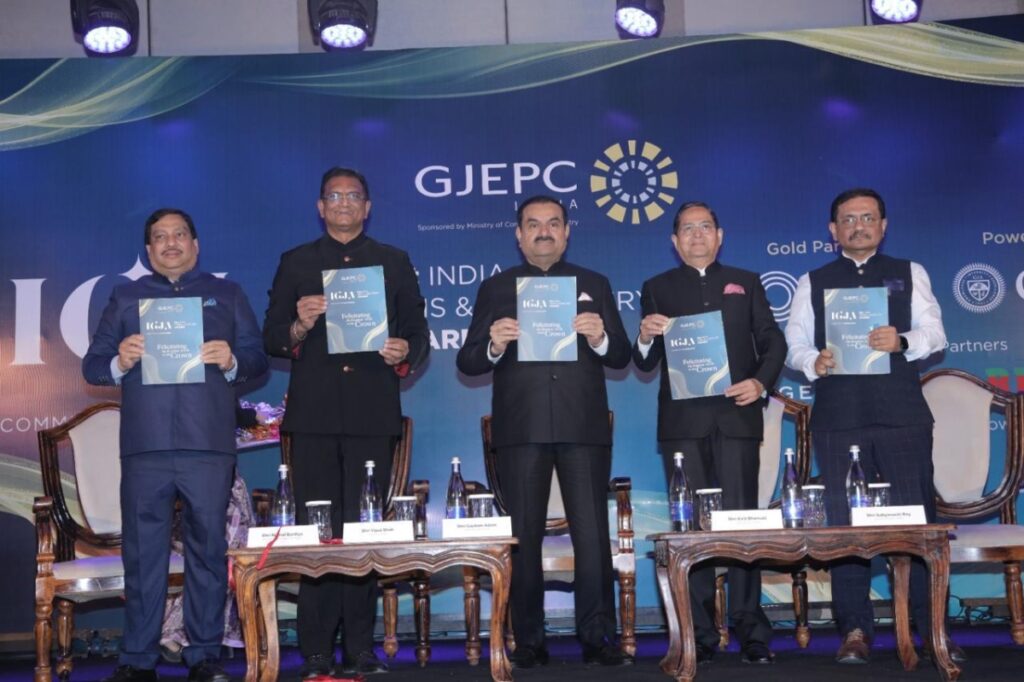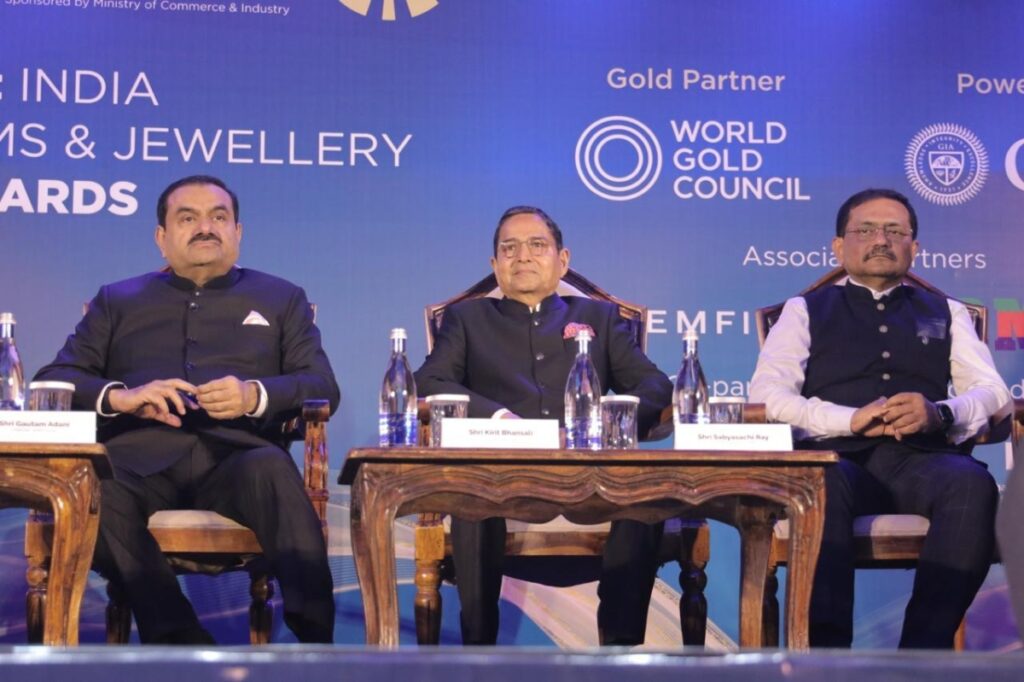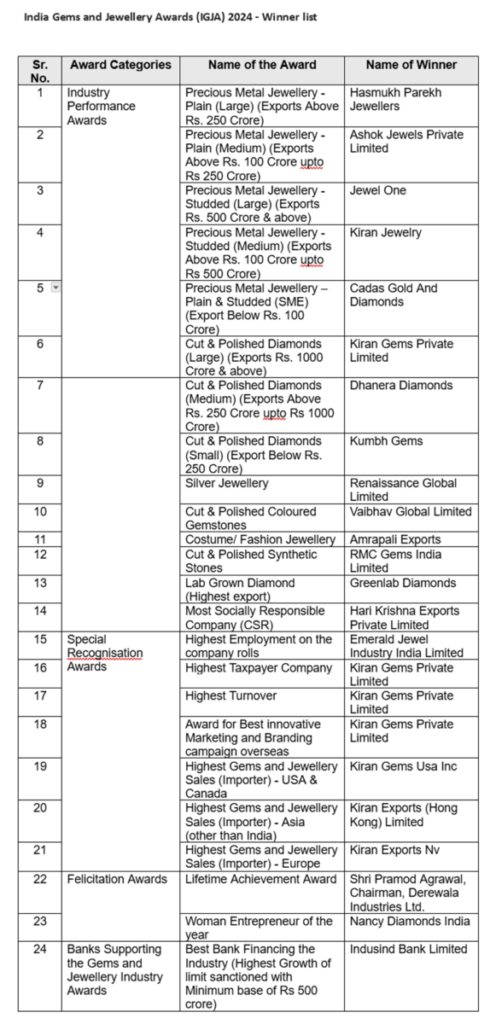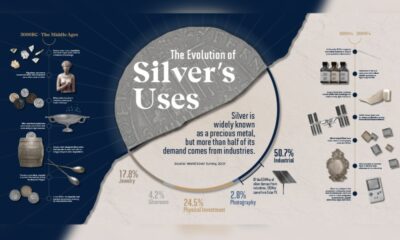JB Insights
GJEPC’s 51st India Gem & Jewellery Awards held in Jaipur
Presiding Guest Gautam Adani says technology & sustainability are twin pillars of our future
Shri 24 awards presented at IGJA 2023-24


The Gem & Jewellery Export Promotion Council (GJEPC) presented the coveted 51st India Gem & Jewellery Awards (IGJA) held in Jaipur, honouring the leading exporters of the gems & jewellery industry. GJEPC presented a total of 24 IGJ Awards: 14 – Industry Performance Awards; 7- Special Recognition Awards; 2 – Felicitation Awards; and 1- Bank supporting the Gems & Jewellery Industry Awards. Pramod Agrawal (Chairman, Derewala Industries Ltd) wins the Lifetime Achievement Award
Business tycoon Shri Gautam Adani (Chairman, Adani Group) graced GJEPC’s 51st edition of the IGJ Awards as Presiding Guest. Representing GJEPC were Shri Vipul Shah, Chairman, GJEPC; Shri Kirit Bhansali, Vice Chairman, GJEPC; Shri Nirmal Bardiya, Regional Chairman, Rajasthan, GJEPC; Shri Sabyasachi Ray, ED, GJEPC, and Shri Sachin Jain, Regional CEO – India, World Gold Council and Shri Gopal Kumar, Director and General Manager, Gemfields India Pvt. Ltd was also present along with the who’s who and doyens of India’s gem & jewellery industry.
While addressing a packed hall of diamond, gem and jewellery trade, Shri Gautam Adani, Chairman, Adani Group, said, “Technology and sustainability are the twin pillars of our future. As we embrace the digital age, let’s ensure our growth is both innovative and responsible. Empowering and uplifting our skilled artisans and craftsmen with digital tools will propel our jewellery heritage to new heights. Ultimately, our youth are the architects of tomorrow. Let’s nurture their potential, and create an India that shines brightly on the world stage.”
Adani further added, “Innovation and sustainability are not just trends but the foundation for the future of the gem and jewellery industry. From advanced manufacturing techniques to smart wearables, technology is revolutionizing the jewellery industry, offering endless opportunities for customisation and connection. The gem and jewellery industry must embrace change, challenge the status quo, and adapt to evolving consumer needs to remain a global leader.”
Shri Vipul Shah, Chairman, GJEPC addressing the audience said, “Think big, innovate relentlessly, and embrace technology—the future of India’s gem and jewellery industry is brighter than ever. With robust retail growth, projects like the India Jewellery Park in Mumbai, Jaipur’s Gem Bourse, and the Bharat Ratnam Mega CFC are transforming the landscape. Supported by visionary government policies and FTAs, our industry is poised to scale new heights. Together, we can position India as a global leader in gems and jewellery, setting benchmarks for innovation, excellence, and sustainability.”



The selection criteria this year included export performance, value addition, employment generation and investment in R&D among other parameters. In recognition of the business excellence demonstrated by companies that are helping to strengthen ‘Brand India’, GJEPC not only felicitate industry players for their exemplary performance, but also recognizes entities such as banks which play a key role in the growth of the sector.
IGJA has evolved over the years to embrace new categories, including social responsibility, innovation, and entrepreneurship, reflecting the dynamic nature of our industry.

Education
The Science Behind Sparkle: How Lab-Grown Diamonds Are Created
A New Era of Diamond Creation

In recent years, lab-grown diamonds have captured the attention of jewellers, consumers, and investors alike. Beyond their beauty, what makes these gems truly fascinating is the science behind their creation. Unlike imitation stones, lab-grown diamonds share the same physical, chemical, and optical properties as natural diamonds — the only difference lies in their origin.
At the heart of this innovation are two cutting-edge processes: High Pressure High Temperature (HPHT) and Chemical Vapor Deposition (CVD). These methods recreate the intense conditions under which natural diamonds form deep within the Earth, allowing scientists to produce genuine diamonds in a controlled laboratory environment.
HPHT: Diamonds Born Under Extreme Conditions

The High Pressure High Temperature (HPHT) method mimics the natural diamond-forming process that occurs about 150 kilometers below the Earth’s surface.
- Starting Point – The Seed:
A small diamond seed, usually a thin slice of an existing diamond, is placed inside a carbon-rich chamber. - Simulating Nature – Pressure and Heat:
The seed is exposed to extreme conditions — pressures of about 5–6 GPa (equivalent to the pressure at the Earth’s mantle) and temperatures of 1,400–1,600°C. - Crystal Growth:
Under these conditions, the carbon source melts and crystallizes around the diamond seed, forming a larger crystal over several weeks.
The result is a high-quality diamond crystal that is virtually indistinguishable from its natural counterpart. HPHT diamonds often exhibit exceptional clarity and can be produced in a range of sizes and colors, including colorless, yellow, and blue varieties.
CVD: Diamonds Grown in a Plasma Cloud

The Chemical Vapor Deposition (CVD) process is a more recent innovation that uses advanced plasma technology to grow diamonds atom by atom.
- Preparing the Chamber:
A thin diamond seed is placed inside a vacuum chamber filled with carbon-rich gases, typically methane and hydrogen. - Creating Plasma:
The gases are energized using microwaves or lasers, forming a plasma cloud that breaks down the molecular bonds of the gases. - Diamond Formation:
Carbon atoms released from the plasma settle onto the seed layer, crystallizing into pure diamond over the course of several weeks.
The CVD method allows for greater control over purity, color, and size, making it ideal for high-end jewellery applications. It also produces diamonds that are free from many of the inclusions typically found in natural stones.
Technology Meets Sustainability

Both HPHT and CVD processes are transforming the jewellery industry not only through technology but also through sustainability. Lab-grown diamonds require no mining, dramatically reducing environmental impact. Many manufacturers are also transitioning to renewable energy sources to power their production facilities, making these diamonds even more eco-conscious.
Furthermore, traceability is a defining advantage. Every lab-grown diamond can be tracked from its creation, offering complete transparency — a growing priority among modern consumers seeking ethical luxury.
Crafting the Future of Jewellery

As consumer awareness grows, lab-grown diamonds are redefining what it means to own something precious. With their scientific precision, sustainable creation, and stunning beauty, they represent the perfect harmony between innovation and artistry.
-

 BrandBuzz3 days ago
BrandBuzz3 days agoVBJ SINCE 1900 Fiesting Over 2000 Unique Jhumka Designs
-

 National News1 day ago
National News1 day agoIndriya unveils Rajashree, the Bridal Collection of Maharashtra
-

 BrandBuzz1 day ago
BrandBuzz1 day agoMalabar Gold & Diamonds Unveils ‘Chitrangi’ — A Collection That Weaves The Poetry of Tradition Into Every Jewel
-

 International News46 minutes ago
International News46 minutes agoSilver surges more than 5% to $54 as “critical mineral” status reinforces safe-haven appeal









